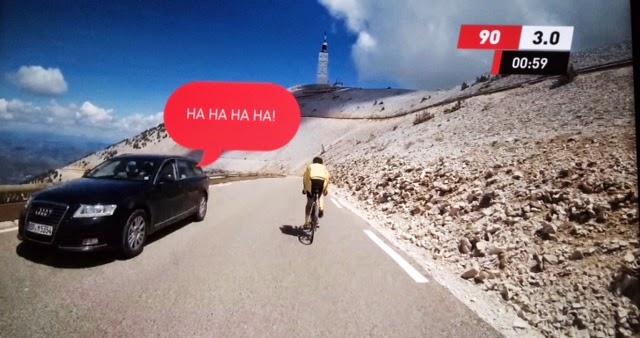Angels 2015 is an updated version of one of The Sufferfest’s
most popular downloads. According to The Sufferfest, the ride is
exactly the same and just the footage and music have been updated. (I’ve only
done the original Angels once and I didn’t read my original review before doing the
updated version or writing this review. I did read my review before posting
this, however, so I would be able to make a fair comparison. You can read my
original review here.)
Angels is
all about the climbs.
Length: 55 minutes (My review for
the original Angels lists the time as 65 minutes.)
Format: after a warmup, there’s a
set of over/under’s. You do one minute just over your threshold (so working at
an RPE of 8/10) and then one minute just under your threshold (an RPE of 7/10).
You do five sets of these for a total of ten minutes. The meat of the workout
is the climbs: three climbs, eight minutes each, with a four-minute recovery in
between each climb.
Music: I loved the music in
Angels. It’s a fun mix of funk, dance, techno and alt-rock. I particularly
enjoyed the music during the final climb—the driving beat helped me push on.
Footage: the race footage comes
from various French cycling races (ie., Liege Bastogne and Paris-Nice). The new
footage is fantastically immersive and really makes you feel like one of the
cyclists (more on this under Other Random Thoughts). Like Nine Hammers, my
favourite footage was the gorgeous mountain shots during the recovery stages.
Difficulty: 8/10. For me, the
toughest part of Angels is the over/unders. I found that the climbs each went
by pretty quickly, most likely due to the ever-changing footage. There was
never time to be bored, which kept my mind off all the suffering. (I also gave the
original Angels an 8/10 for difficulty.)
Other Random Thoughts: I really
enjoyed Angels 2015. I only have two criticisms. The first is that I would
prefer to stand more during the climbs. So when I do this one the next time,
I’ll probably choose to stand for the majority of the climbs. My second
criticism is that there isn’t much of a storyline. You’re pitted against the
great climbers but I didn’t find that there was much story continuity between
the three climbs.
There comes a point when the minions seem to forget that they're there to torture you and seem to be on the verge of mushiness and kindness:
They do throw out encouraging nuggets of wisdom from time to time:
In reading my original review, I
realized that The Sufferfest made a big change to the final climb. In the
original Angels, the third climb has you ascending the gorgeous Alpe d’Huez. In
the 2015 version, you climb the Angliru, said to be the most difficult climb in
Europe. I’d have to concur with that assessment—check out the grade:
A 21% incline. You’re pitted against one of the great climbers,
Nibali, and even he’s only managing a speed of 11 km/h. (Speaking of riders, the original Angels pits
you against Contador, who sadly seems to be MIA in the updated version.)
It may be the toughest climb in Europe but the minions insist that you look on the bright side:
One of the things I love most
about The Sufferfest is the immersive experience it gives you—you really feel
like one of the riders. This is particularly true during the final climb, when
you see and feel the cheering crowd closing in on you:
On the one hand, the cheering
crowds really help push you on. On the other hand, if I was riding through this
throng in real life, you can bet I’d be packing my cattle prod.
Overall I loved the updated version of Angels. Despite the lack of a strong storyline, there's enough here to make me want to do this one again soon. 8.5/10. (I gave the original Angels an 8/10.)



















